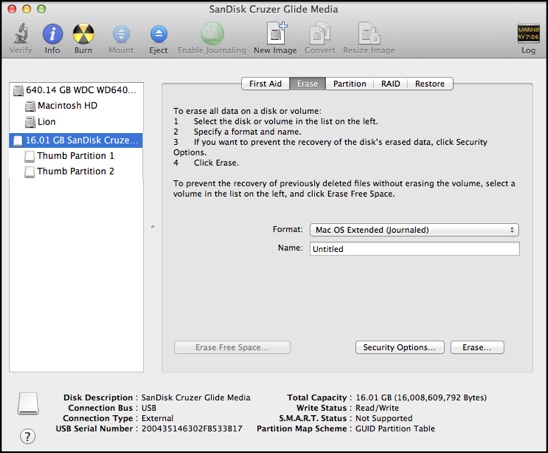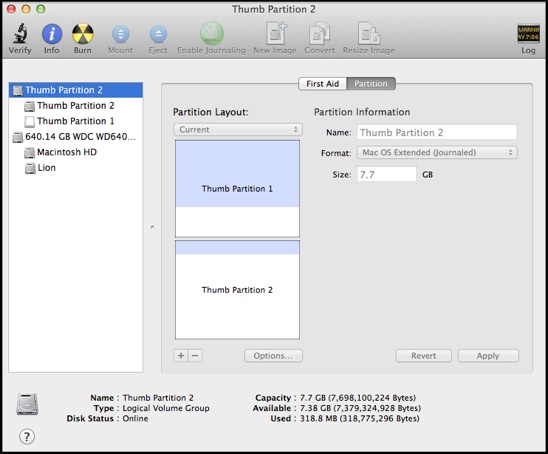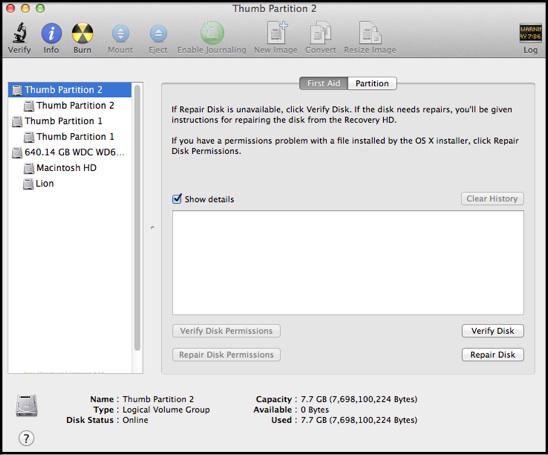Apple Tips: Using Disk Utility
8. Disk Formats
Apple Tips: Using Disk Utility
8. Disk Formats
There are four variations of the Mac OS Extended Format (also known as HFS+):
•Mac OS Extended
•Mac OS Extended (Journaled)
•Mac OS Extended (Case-sensitive)
•Mac OS Extended (Case-sensitive, Journaled)
Effective with Lion, if the disk has the GUID Partition Map Scheme, you can use encryption:
•Mac OS Extended (Journaled, encrypted)
•Mac OS Extended (Case-sensitive, Journaled, encrypted)
See the pink box below for details and considerations on encryption.
These options are not supported for drives connected to Airport Extremes or Time Capsules.
Journaling makes file system recovery after a crash (due to lost of power, improper disconnection, software glitch, etc.) faster. It is required for a Time Machine volume, and generally recommended for all others. If in doubt, use it.
Case-sensitive means CAPITAL LETTERS in file names are different from lower-case letters. That means you could have two or more files with the same name in the same folder, such as MYFILE, MyFile, and myfile. This can cause all sorts of problems, and some apps won’t run well, if at all, on a case-sensitive volume. But a few, unfortunately, require it. So avoid it if at all possible.
There are also the options of:
•MS-DOS (FAT) (with GUID and MBR Partition Map only)
•ExFAT (effective with 10.6.5, with GUID and MBR Partition Map only)
•Free Space (when doing a complete reformat only)
MS-DOS(FAT) also called FAT32, may be useful if you want both a Mac and PC to be able to read and write to it. There are some drawbacks, such as a maximum file size of 4 GB; and the partition name must be in CAPITAL LETTERS and no more than 11 characters.
ExFAT is also useful for exchange with PCs, without the 4 GB maximum file size. Note it is not supported on USB drives connected to Airport Extremes or Time Capsules.
Free Space is not usable at all. To use it, you must click in the empty area and add a partition.
Partitions to be used by Boot Camp must be added and managed by Boot Camp Assistant only. See Mac 101: Using Windows on your Mac via Boot Camp for details.
Encryption of an entire disk or one or more partitions is the most reliable way to protect your data if the disk is lost or stolen.
You can encrypt your OSX drive (Startup volume), via System Preferences > Security & Privacy > File Vault without erasing it. In addition, you can select other users who can unlock and access the disk, and can register an "encryption key" with Apple in case you lose the password.
You can also encrypt an existing Time Machine disk/partition without erasing it, via the Encrypt Backups box when selecting a backup drive. See Time Machine FAQ #31 for details.
Otherwise, you can only encrypt a drive or partition by erasing it and choosing one of the encrypted formats. When you do that, you'll be prompted to create a password. As noted prominently, if you forget the password, you cannot recover the data.
The password must be used to access the drive -- you'll be prompted when you connect it; but thereafter you won't be prompted again until the drive is ejected and re-connected.
Other than needing the encryption password to "unlock" or "mount" it, in most cases, there isn't much difference in the way they work. But, of course, there are exceptions.
There are a number of restrictions:
•You cannot format a disk with an encrypted format. You must first use an unencrypted format, then erase the partition with an encrypted format. If you want multiple partitions, you must do that first, with non-encrypted formats, then erase and encrypt the desired partition(s).
•You cannot reformat the disk. You must erase each encrypted partition, using a non-encrypted format, first.
•You cannot split or alter the size of any partitions on the drive.
•You cannot remove any encrypted partitions.
•You cannot use the RAID or Restore tabs on the entire disk, or any encrypted partitions.
Disk Utility displays such a disk rather differently:
•The drive is shown with the gray icon of an internal disk, even if it's an external drive.
•The drive is shown at the top of the sidebar, above the "real" internal HD.
•The top line for the drive (that usually carries the make and size) is the same as the name of the (first) encrypted partition.
•If there are multiple encrypted partitions, each one is shown as a separate drive (3rd sample).
•If there are multiple partitions, some encrypted and some not, the encrypted partition(s) are shown first.
Here's an example of a USB thumb drive, before and after the second partition was encrypted:


